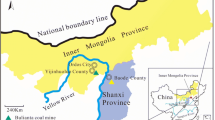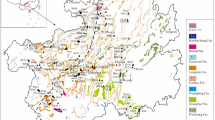Abstract
Global issues such as pollution and global warming have resulted in changes in water characteristics over the past 20 years. Natural organic matter (NOM) which is a major component in water systems has shown an increase globally. This increase in NOM concentration has negatively affected both water treatment processes and drinking water quality. It is subsequently critical to understand the seasonal variations and composition of NOM to be able to address issues related to NOM. In this study, techniques such as ultraviolet–visible spectroscopy, total organic carbon and liquid chromatography-organic carbon detection (LC-OCD) were used for characterisation and quantification of NOM. Two coal-fired power stations were selected for this study with each power station receiving water from a different source, i.e. power station A receives water from the Vaal River and power station B from the Nkomati River. Results from this study demonstrated that composition and concentration of NOM from these two water sources varied seasonally. Characterisation of NOM using the LC-OCD indicated that the different fractions of NOM, i.e. low molecular weight neutrals, low molecular weight acids, building blocks, humic substances and biopolymers, varied seasonally. The dissolved organic carbon concentration and specific ultraviolet absorbance values of the raw water at both power stations showed an increment amid the wet seasons and a decrease amid the dry seasons.





Similar content being viewed by others
Availability of data and materials
The authors confirm that all the data supporting the findings are available within the manuscript as presented in tables and figures.
References
Abokifa AA et al (2016) Investigating the role of bio films in trihalomethane formation in water distribution systems with a multicomponent model. Water Res 104:208–219
Aschermann G et al (2016) Seasonal variation of organic matter concentration and characteristics in the Maji ya Chai River (Tanzania): impact on treatability by ultra filtration. Water Res 101:370–381
Awad J et al (2017) Seasonal variation in the nature of DOM in a river and drinking water reservoir of a closed catchment. Environ Pollut 220:788–796
Ayekoe CYP, Robert D, Lanciné DG (2017) Combination of coagulation-flocculation and heterogeneous photocatalysis for improving the removal of humic substances in real treated water from Agbô River (Ivory-Coast). Catal Today 281:2–13
Badawy MI et al (2012) Minimization of the formation of disinfection by-products. Chemosphere 89:235–240
Baghoth SA, Sharma SK, Amy GL (2011) Tracking natural organic matter (NOM) in a drinking water treatment plant using fluorescence excitation emission matrices and PARAFAC. Water Res 45:797–809
Chen M et al (2016) Tracking the monthly changes of dissolved organic matter composition in a newly constructed reservoir and its tributaries during the initial impounding period. Environ Sci Pollut Res 23(2):1274–1283
Ebrahimzadeh et al (2021) Relationship between algae diversity and water quality- a case study: Chah Niemeh reservoir Southeast of Iran. J Environ Health Sci Eng 19:437–443
Eikebrokk B, Juhna T, Østerhus SW (2006) Water treatment by enhanced coagulation – Operational status and optimization issues. Techneau Report D 5.3.1 A. Techneau, Nieuwegein, The Netherlands
Gouws K, Coetzee PP (1997) Determination and partitioning of heavy metals in sediments of the Vaal Dam system by sequential extraction. Water SA 23(3):217–226
Garcia Knapik H, Scapulatempo Fernandes CV, Rodrigues de Azevedo JC (2011) Characterization of organic matter using fluorescence and absorbance spectroscopy: the case study of a Brazilian polluted river. In 4th IWA Specialty Conference on Natural Organic Matter. Bath, United Kingdom, pp 1–15
Ghernaout D (2014) The hydrophilic/hydrophobic ratio vs. dissolved organics removal by coagulation - a review. J King Saud Univ - Sci 26:169–180
Gungor EBO, Bekbolet M (2010) Zinc release by humic and fulvic acid as influenced by pH, complexation and DOC sorption. Geoderma 159(1–2):131–138
Huber SA et al (2011) Characterisation of aquatic humic and non-humic matter with size-exclusion chromatography - organic carbon detection - organic nitrogen detection (LC-OCD-OND). Water Res 45:879–885
Korotta-Gamage SM, Sathasivan A (2017) A review: potential and challenges of biologically activated carbon to remove natural organic matter in drinking water purification process. Chemosphere 167:120–138
Leenheer JA, Croué JP (2003) Characterising dissolved aquatic organic matter. Environ Sci Technol 37(1):18A-26A
Leithold J et al (2017) Quali-quantitative characterization of organic matter in urbanized drainage basins as a basis for the application of Water Resources Management Instruments. Braz J Water Resour 22(55):1–10
Li C et al (2017) Formation of known and unknown disinfection by-products from natural organic matter fractions during chlorination, chloramination, and ozonation. Sci Total Environ 587–588:177–184
Ling TY et al (2017) Seasonal changes and spatial variation in water quality of a large young tropical reservoir and its downstream river. J Chem 2017:1–16
Liu T et al (2017) Effect of fluid flow on biofilm formation and microbiologically influenced corrosion of pipelines in oilfield produced water. J Petrol Sci Eng 40(38):1–21
Matilainen A et al (2002) Removal of NOM in the different stages of the water treatment process. Environ Int 28:457–465
Matilainen A et al (2011) An overview of the methods used in the characterisation of natural organic matter (NOM) in relation to drinking water treatment. Chemosphere 83(11):1431–1442
Matilainen A, Sillanpää M (2010) Removal of natural organic matter from drinking water by advanced oxidation processes. Chemosphere 80(4):351–365
Matilainen A, Vepsäläinen M, Sillanpää M (2010) Natural organic matter removal by coagulation during drinking water treatment: a review. Adv Coll Interface Sci 159(2):189–197
Nkambule TI et al (2009) Characterisation of natural organic matter (NOM) and its removal using cyclodextrin polyurethanes. Water SA 35(2):200–203
Pan Y et al (2016) Characterization of natural organic matter in drinking water: sample preparation and analytical approaches. Trends Environ Anal Chem 12:23–30
Papageorgiou A et al (2017) Effects of ozonation pretreatment on natural organic matter and wastewater derived organic matter: possible implications on the formation of ozonation by-products. Chemosphere Elsevier Ltd 170:33–40
Park JW et al (2016) Influences of NOM composition and bacteriological characteristics on biological stability in a full-scale drinking water treatment plant. Chemosphere 160:189–198
Peters CD et al (2021) Retention of natural organic matter by ultrafiltration and the mitigation of membrane fouling through pre-treatment, membrane enhancement, and cleaning - a review. J Water Process Eng 44:102374–102402
Peuravuori J, Pihlaja K (2007) Characterisation of freshwater humic matter. CRC Press, Handbook of Water Analysis, pp 435–448
Rutlidge H et al (2015) Organic characterisation of cave drip water by LC-OCD and fluorescence analysis. Geochim Cosmochim Acta 166:15–28
Schoombie SW, Cloot A, Le Roux G (1997) A dynamic model for algal growth in the Vaal River. Report by the Water Research Commission, Department of Mathematics and Applied Mathematics, University of Orange Free State, WRC report no 536/1/97, pp 1–141. https://www.wrc.org.za/wpcontent/uploads/mdocs/536-1-97.pdf
Selberg A et al (2011) Content and composition of natural organic matter in water of Lake Pitkjärv and mire feeding Kuke River (Estonia). J Hydrol 400(1–2):274–280
Shaw JLA et al (2014) Assessing the impact of water treatment on bacterial biofilms in drinking water distribution systems using high-throughput DNA sequencing. Chemosphere 117:185–192
Sklivaniotis M, Angelakis AN (2006) ‘Water for human consumption through history’. In International Symposium on Water and Wastewater Technologies in Ancient Civilizations, pp 659–666. Iraklio, Greece. https://www.itia.ntua.gr/en/getfile/1224/1/documents/2006WWTAC_1.pdf. Accessed 27 Sep 2022
So SH et al (2017) Seasonally related effects on natural organic matter characteristics from source to tap in Korea. Sci Total Environ 592:584–592
Suksaroj C, Chaimongko P, Wattanachira P, Musikavong S (2008) Characterization and treatment of natural organic matter from raw water supply reservoir in Thailand. KKU Res J 13(9):1098–1106
Umar M, Roddick F, Fan L (2014) Effect of coagulation on treatment of municipal wastewater reverse osmosis concentrate by UVC/H2O2. J Hazard Mater 266:10–18
van Vuuren L (2014) THE VAAL RIVER – South Africa’s water workhorse. The Water Wheel July/August 2014, p 44–45. https://www.wrc.org.za/wp-content/uploads/mdocs/WWJuly2014_waterkidz.pdf. Accessed 27 Sep 2022
Vasyukova E et al (2013) Removal of natural organic matter and trihalomethane formation potential in a full-scale drinking water treatment plant. Water Sci Technol: Water Supply 13(4):1099–1108
Wang FH et al (2014) Bench-scale and pilot-scale evaluation of coagulation pre-treatment for wastewater reused by reverse osmosis in a petrochemical circulating cooling water system. Desalination 335(1):64–69
Wang H, Zhu Y, Hu C (2017) Impacts of bacteria and corrosion on removal of natural organic matter and disinfection byproducts in different drinking water distribution systems. Int Biodeterior Biodegradation 117:52–59
Yamamura H et al (2014) Hydrophilic fraction of natural organic matter causing irreversible fouling of microfiltration and ultrafiltration membranes. Water Res 54:123–136
Funding
The authors wish to thank the National Research Foundation Competitive Support for Unrated Researchers (SRUG210407592746), the Water Research Commission (Project No.: K52488//3), the National Research Foundation-Competitive Support for Unrated Researchers (SRUG210407592746), the South Africa/India Joint Science and Technology Research Collaboration (IND190911475982) and the Centre for Nanomaterials and Science Research (University of Johannesburg) for funding and the Eskom Research, Testing and Development Business Unit for resources that were made available for this research.
Author information
Authors and Affiliations
Contributions
SH Mojela: data collection, methodology, formal analysis, validation, writing—original draft. H Madhav: conceptualisation, methodology, resources, supervision, writing—review and editing. G Gericke: conceptualisation, methodology, resources, supervision, writing—review and editing. SP Malinga: conceptualisation; methodology; resources; supervision; writing—review and editing; project administration and funding acquisition.
Corresponding author
Ethics declarations
Consent to participate
We confirm that this work does not involve any research on human or animals. Thus, no consent was required in this case.
Consent to publish
All authors have agreed to publish this article.
Conflict of interest
The authors declare no competing interests.
Additional information
Responsible Editor: Philippe Garrigues
Publisher's Note
Springer Nature remains neutral with regard to jurisdictional claims in published maps and institutional affiliations.
Rights and permissions
Springer Nature or its licensor holds exclusive rights to this article under a publishing agreement with the author(s) or other rightsholder(s); author self-archiving of the accepted manuscript version of this article is solely governed by the terms of such publishing agreement and applicable law.
About this article
Cite this article
Mojela, H., Gericke, G., Madhav, H. et al. Seasonal variations of natural organic matter (NOM) in surface water supplied to two coal-fired power stations. Environ Sci Pollut Res 30, 15454–15463 (2023). https://doi.org/10.1007/s11356-022-23239-7
Received:
Accepted:
Published:
Issue Date:
DOI: https://doi.org/10.1007/s11356-022-23239-7




